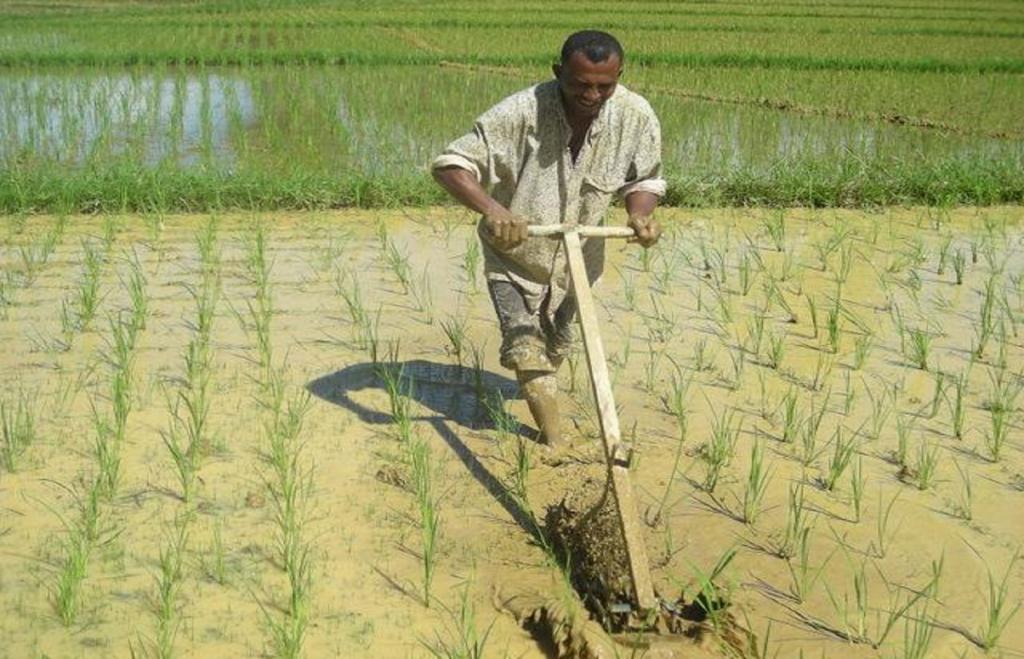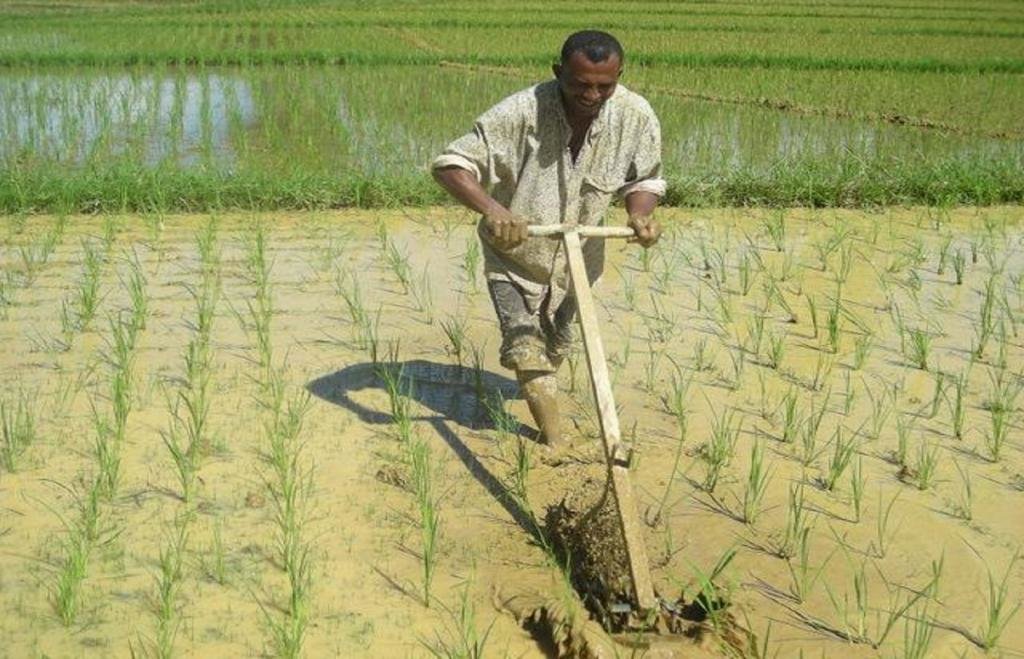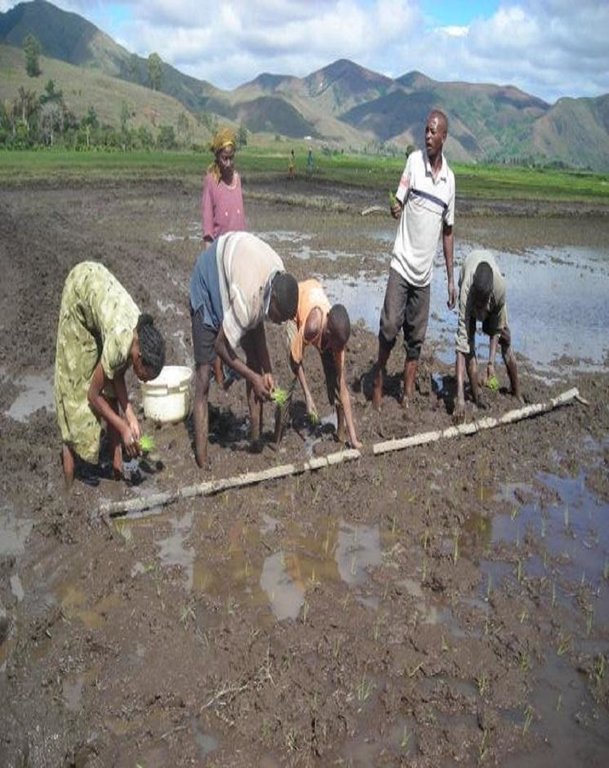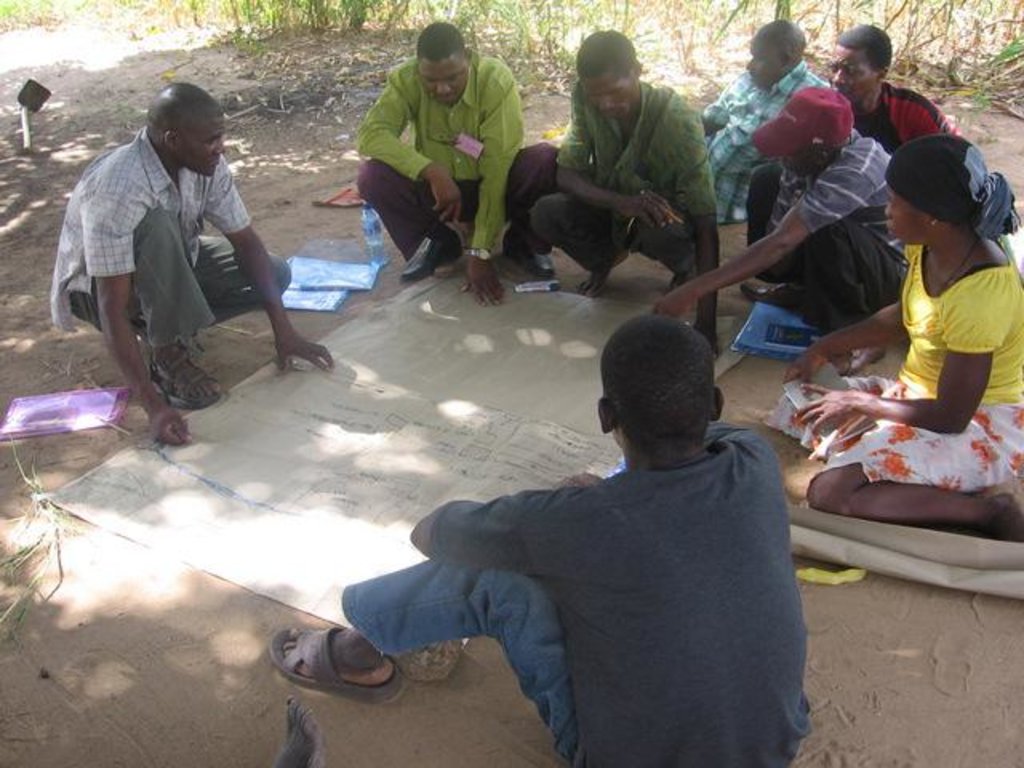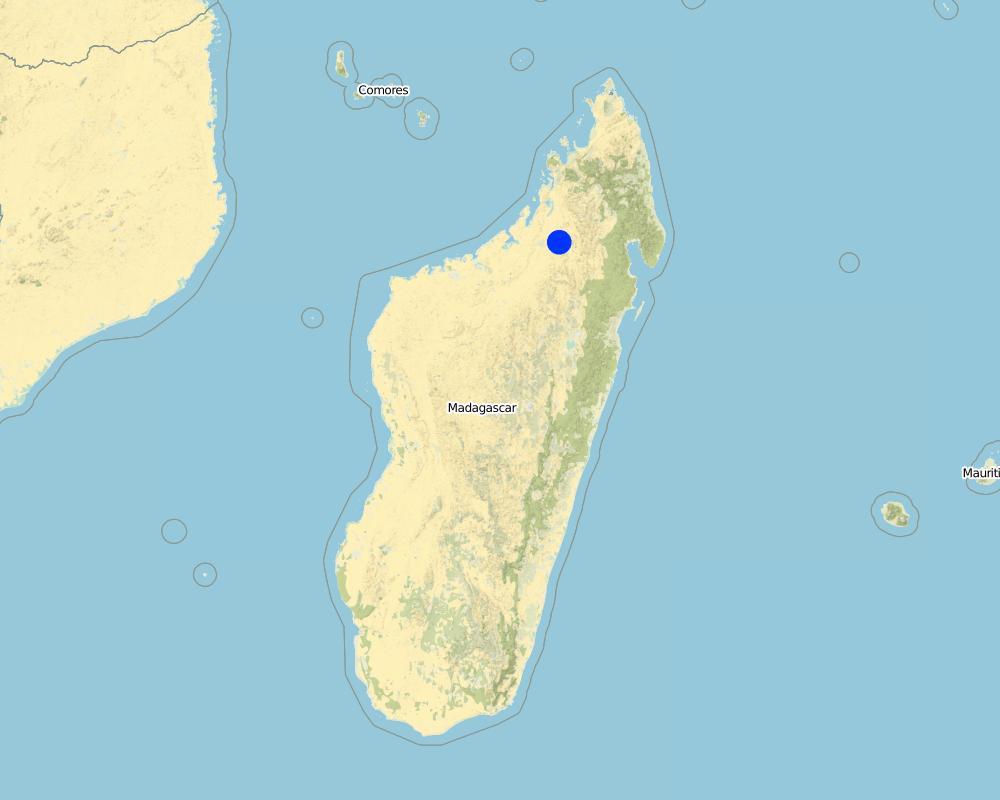Participatory Learning and Action Research approach to Integrated Rice Management [Madagascar]
- Creación:
- Actualización:
- Compilador: Unknown User
- Editor: –
- Revisor: Fabian Ottiger
approaches_2571 - Madagascar
Visualizar secciones
Expandir todo Colapsar todos1. Información general
1.2 Detalles de contacto de las personas de referencia e instituciones involucradas en la evaluación y la documentación del Enfoque
Agric. R&D consultant:
Defoer Toon
tdefoer@aliceadsl.fr
Najac, France
Francia
Especialista MST:
Wopereis Marco
wopereis@cgiar.org.
Africa Rice Center
Cotonou
Benin
Nombre de la(s) institución(es) que facilitaron la documentación/ evaluación del Enfoque si fuera relevante)
CDE Centre for Development and Environment (CDE Centre for Development and Environment) - SuizaNombre de la(s) institución(es) que facilitaron la documentación/ evaluación del Enfoque si fuera relevante)
Africa Rice Center (AfricaRice) - Costa de Marfil1.3 Condiciones referidas al uso de datos documentados mediante WOCAT
El compilador y la/s persona(s) de referencia claves aceptan las condiciones acerca del uso de los datos documentados mediante WOCAT :
Sí
2. Descripción del Enfoque MST
2.1 Breve descripción del Enfoque
The Participatory Learning and Action Research approach to Integrated Rice Management (PLAR-IRM) is a bottom-up, social and experiential learning approach, leading to sustainable agricultural improvements, based on mutual support and communication among farmers.
2.2 Descripción detallada del Enfoque MST
Descripción detallada del Enfoque MST:
Aims / objectives: Innovation and agricultural change is aimed for, through capacity strengthening of all major stakeholders involved in the rice sub-sector. IRM refers to the production system and value chain as a whole. Innovation is not limited to technological change; it also includes time management and the building of social networks and institutions for mutual collaboration between farmers and other stakeholders within the rice value chain. A step-wise, self-discovery learning mode encourages the stakeholders to find solutions for their own site-specific problems. During the first years, groups of 25-30 producers are supported by a programme facilitator who animates the learning and innovation sessions. The main instruments are the learning modules dealing with specific crop management practices, harvest and post-harvest practices (involving processors and entrepreneurs also), as well as the agro-ecological and socio-economic conditions of rice production. The sessions aim to strengthen farmers’ and other rice stakeholders' capacity to observe, analyze, interpret, make decisions, innovate and share knowledge and experiences. PLAR is based on locally relevant knowledge, practices and skills. Exchanges about current practices, and their logic or justification, are the starting point in all modules.
Methods: In a learning-by-doing approach farmers are encouraged to try out any new ideas identified during PLAR sessions on some parts of their fields reserved for new practices (“innovation space”). This allows them to assess the impact of such innovations on their rice yield, or on the profitability of rice growing and the rice business as a whole, and consequently to adapt and fine-tune the measures taken according to their needs. These innovation spaces are regularly visited as part of learning sessions for knowledge sharing between farmers. Since 2005, innovations in land preparation, early transplanting of seedlings, weeds and water management - basically without external inputs - have resulted in three times higher yields, benefitting thousands of farmers. Rice value chain activities started in 2008 with a view to empowering farmers' position within the chains and improving the competitiveness. Groups are unifying into PLAR centres with common marketing of rice, and contract input providers and rice processors.
2.3 Fotos del Enfoque
2.5 País/ región/ lugares donde el Enfoque fue aplicado
País:
Madagascar
Especifique más el lugar :
Sofia Region
Map
×2.7 Tipo de Enfoque
- proyecto/ basado en un programa
2.8 Propósitos/ objetivos principales del Enfoque
The Approach focused mainly on SLM with other activities (value chain develop¬ment: collective storage and marketing of rice; contractual arrangements with input providers and rice processors)
Sustainably improving food security, livelihoods and incomes of poor rice farmers by boosting the profitability of rice production and increasing the efficiency and competitiveness of the rice sub-sector; Capacity strengthening of all stake-holders involved in the rice-subsector
The SLM Approach addressed the following problems: Low yields in rice production; Most farmers live below subsistence level; Absence of government and NGO support; Limited access to markets, lack of infrastructure
3. Participación y roles de las partes interesadas involucradas
3.1 Partes interesadas involucradas en el Enfoque y sus roles
- usuarios locales de tierras/ comunidades locales
rice farmers
marginalised poor rice farmers are targeted
- sector privado
private service providers (e.g. input suppliers), rice processors and buyers
- gobierno local
- organización internacional
Aga Khan Foundation
3.2 Involucramiento de los usuarios locales de tierras/ comunidades locales en las distintas fases del Enfoque
| Involucramiento de los usuarios locales de tierras/ comunidades locales | Especifique quién se involucró y describa las actividades | |
|---|---|---|
| iniciación/ motivación | interactivo | |
| planificación | interactivo | |
| implementación | interactivo | |
| monitoreo y evaluación | ninguno | |
| Research | ninguno |
3.4 La toma de decisiones en la selección de Tecnología(s) MST
Especifique quién decidió la selección de las Tecnología/ Tecnologías a implementarse:
- solamente usuarios de tierras (autoiniciativa)
Explique:
Decisions on the method of implementing the SLM Technology were made by mainly by land users supported by SLM specialists
4. Apoyo técnico, fortalecimiento institucional y gestión del conocimiento
4.1 Construcción de capacidades / capacitación
¿Se proporcionó la capacitación a usuarios de tierras/ otras partes interesadas?
Sí
Especifique quién fue capacitado:
- usuarios de tierras
- personal de campo/ consejeros
Forma de capacitación:
- en el contexto de trabajo
- de agricultor a agricultor
Temas avanzados:
crop management practices, harvest and post-harvest practices (incl. storage, marketing), socio-economic and ecological conditions of rice farming; curriculum based on needs assessment
4.2 Servicio de asesoría
¿Los usuarios de tierras tienen acceso a un servicio de asesoría?
Sí
Especifique si servicio proporcionado se realizó:
- en los campos de los usuarios de tierras
Describa/ comentarios:
Name of method used for advisory service: modular learning sessions guided by a facilitator, farmer-to-farmer extension; Approach is based on indigenous knowledge
4.5 Investigación
¿La investigación formó parte del Enfoque?
Sí
Proporcione detalles adicionales e indique quién hizo la investigación:
crop management practices
Research was carried out on-farm
5. Financiamiento y apoyo material externo
5.1 Presupuesto anual para el componente MST del Enfoque
Si no se conoce el presupuesto anual preciso, indique el rango:
- 100,000-1,000,000
Comentarios (ej. fuentes principales de financiamiento/ donantes principales):
Approach costs were met by the following donors: international: 10.0%; national non-government: 30.0%; private sector: 10.0%; local community / land user(s): 50.0%
5.2 Apoyo financiero/material proporcionado a los usuarios de tierras
¿Los usuarios de tierras recibieron financiamiento/ apoyo material para implementar la Tecnología/ Tecnologías? :
Sí
5.3 Subsidios para insumos específicos (incluyendo mano de obra)
- equipo
| Especifique qué insumos se subsidiaron | En qué grado | Especifique los subsidios |
|---|---|---|
| herramientas | totalmente financiado | Two sarcleuses (weeding equipment) per starting group are provided for free and remain property of the group |
Comentarios:
Two sarcleuses (weeding equipment) per starting group are provided for free and remain property of the group
5.4 Crédito
¿Se proporcionó crédito bajo el Enfoque para actividades MST?
Sí
Especifique las condiciones (tasa de interés el apoyo, amortización, etc.):
Interest rate charged: 2.5%; repayment conditions: Was supported by the approach in collaboration with an existing microfinance institution; loan period: 6-8 months, 2.5% monthly (!) interest rate.
6. Análisis de impacto y comentarios de conclusión
6.1 Impactos del Enfoque
¿El Enfoque ayudó a los usuarios de tierras a implementar y mantener Tecnologías MST?
- No
- Sí, un poco
- Sí, moderadamente
- Sí, mucho
yields have increased by > 200% (on innovation spaces)
¿El Enfoque empoderó a grupos en desventaja social y económica?
- No
- Sí, un poco
- Sí, moderadamente
- Sí, mucho
marginalised poor rice farmers are targeted
Did other land users / projects adopt the Approach?
- No
- Sí, un poco
- Sí, moderadamente
- Sí, mucho
from 2005-2009 PLAR groups have increased from 6 up to 102, involving 3782 families and extended to 4200 non grouped farmers
Did the Approach help to alleviate poverty?
- No
- Sí, un poco
- Sí, moderadamente
- Sí, mucho
SLM practices result into a net benefit of > 700 US$/ha
6.2 Motivación principal del usuario de la tierra para implementar MST
- producción incrementada
- incremento de la renta(bilidad), proporción mejorada de costo-beneficio
- afiliación al movimiento/ proyecto/ grupo/ redes
6.3 Sostenibilidad de las actividades del Enfoque
¿Pueden los usuarios de tierras sostener lo que se implementó mediante el Enfoque (sin apoyo externo)?
- sí
Si respondió que sí, describa cómo:
In a 2nd phase farmers who are organised in PLAR groups gradually build up the capacity to manage the innovation and mutual learning approach on their own without programme support: Farmers facilitators are trained to take over the lead of PLAR groups with backstopping from programme facilitators.
6.4 Fortalezas/ ventajas del Enfoque
| Fuerzas/ ventajas/ oportunidades desde la perspectiva del compilador o de otra persona de referencia clave |
|---|
| Farmers learn basic principles of rice management and develop their own locally adapted options for improvements; the innovation comes from inside the groups. |
| Farmers build up individual and organisational capacity to find solutions to their problems and build confidence as efficient partners with other value chain actors. |
6.5 Debilidades/ desventajas del Enfoque y formas de sobreponerse a ellos
| Debilidades/ desventajas/ riesgos desde la perspectiva del compilador o de otra persona de referencia clave | ¿Cómo sobreponerse a ellas? |
|---|---|
| Labour intensive improvements | provision of group credit to PLAR group members in collaboration with a local microfinance institution |
| Learning intensive approach, with regular group learning sessions | PLAR groups elaborate their own learning programmes and curricula according to their availability and needs |
7. Referencias y vínculos
7.1 Métodos/ fuentes de información
- visitas de campo, encuestas de campo
- entrevistas con usuarios de tierras
7.2 Referencias a publicaciones disponibles
Título, autor, año, ISBN:
Defoer T., M. Wopereis, S. Diack, and P. Idinoba. 2008. Apprentissage participatif et recherche action pour la gestion intégrée du riz à Madagascar: Manuel du facilitateur AKF, Genève, Suisse. Defoer T., M. Wopereis, P. Idinoba T. and Kadisha. 2006. Participatory Learning and Action Reseaerch (PLAR) for Integrated Rice Management in inland valleys in sub-saharan Africa: Facilitators’ manual. WARDA- the Africa Rcie Center, Bouaké, Côte d’Ivoire.
Título, autor, año, ISBN:
Defoer T., M. Wopereis, P. Idinoba T. and Kadisha. 2006. Participatory Learning and Action Reseaerch (PLAR) for Integrated Rice Management in inland valleys in sub-saharan Africa: Facilitators’ manual. WARDA- the Africa Rcie Center, Bouaké, Côte d’Ivoire.
Vínculos y módulos
Expandir todo Colapsar todosVínculos
No hay vínculos
Módulos
No se hallaron módulos


